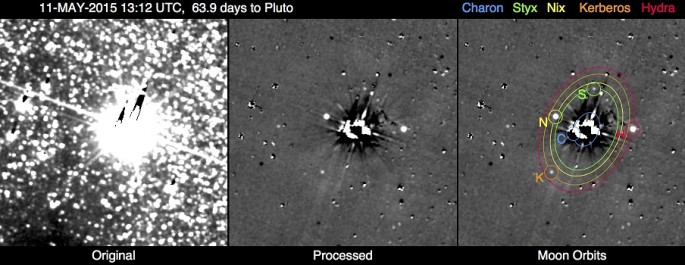The much anticipated NASA spacecraft that is zooming towards Pluto appears to have a clear and safe path for now.
The New Horizons spacecraft is now on its final stretch of its journey for its July 14 rendezvous with the dwarf planet which will mark the first ever close up encounter of Pluto that could reveal a rich and complex surface.
During the start of this month, the mission team began to hunt for hidden moons and rings of Pluto that may pose as a danger to the spacecraft with the help of the probe's long range camera. Currently, the spacecraft is hurtling towards the Pluto system at speeds of 32,500 miles per hour where collisions with space objects even as tiny as a pebble can prove disastrous to New Horizons due to its velocity.
NASA revealed the first hazard-search images that were captured from May 11 to May 12 from a distance of 47 million miles from Pluto. The images revealed no new moons or rings or any space debris that might get in the way of New Horizons according to an announcement from the mission team on Thursday, May 28.
New Horizons already completed the task of spotting all five known moons which are Nix, Styx, Charon, Hydra and Kerberos from an initial search where scientists believe that they will find another one that possesses half the brightness of Styx which is the faintest moon of Pluto.
According to a mission update, any moons that are discovered outside the largest and closest moon which is Charon will probably measure three to 10 miles in diameter. If there are also any undiscovered rings that are present in Pluto outside Charon's current orbit, it must be so indistinct that it could be less than 1,000 miles wide.
The next series of hazard search images will be taken from May 29 to May 30 where observations will still continue through July 1 as images will become twice as sensitive as the initial series.
However, if something was detected that might harm the spacecraft along its way towards Pluto, there are two options to ensure safety for New Horizons.
The first option is to divert the planned trajectory for 7,800 miles from Pluto's surface from three alternative routes where this can be adjusted until July 4. The second option will rely on the spacecraft's high gain antenna forward that can be used as a shield.
The mission team however claims that there is no need to resort to drastic measures as prior and current analyses and observations confirm that the spacecraft's path is safe. The craft is now currently travelling at a rate of 1.2 million kilometers every day towards Pluto.



























